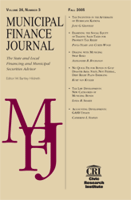E-Commerce and the Single-Rate Sales Tax Proposal
Author: Gary C. Cornia (1).; Kelly D. Edmiston (2) David L. Sjoquist (2).; Steven M. Sheffrin (3).; Terri A. Sexton (4).; C. Kurt Zorn (5).
Source: Volume 22, Number 03, Fall 2001 , pp.1-23(23)

next article > |return to table of contents
Abstract:
Compliance burdens associated with the increasing complexity of the sales tax system have resulted in numerous calls for modification of state and local sales tax rates to reduce compliance costs. An electronic commerce (e-commerce) recommended the adoption, within each state, of a single statewide sales and use tax rate (National Tax Association, 1999). This recommendation grew out of concern over the potential loss of sales tax revenue from e-commerce and the need to address U.S. Supreme Court rulings regarding the collection of use taxes from remote vendors. Concern over the loss of tax revenue from catalog sales made by out-of-state vendors led to lawsuits that resulted in two U.S.Supreme Court decisions: National Bellas Hess v. Department of Revenue of Illinois, 386 U.S. 753 (1967), and Quill v. North Dakota, 504 U.S. 298 (1992). In both cases the Court ruled that states cannot require out-of-state vendors to collect and remit the use tax on remote sales. The compelling argument in both cases was the assertion that vendors would experience an undue burden if required to collect the tax at the point of sale because of the large number of and variation in local sales and use tax rates within and among states. This article tests the feasibility of a state-wide uniform local rate in California, Georgia, New York, Tennessee and Utah. A research team of expert economists integrates state case studies into a compelling review of the barriers to a uniform local sales tax rate for states.Keywords: Revenue autonomy; debt implications; rate setting; earmarking; temporary sales taxes; border competition; service districts
Affiliations:
1: Brigham Young University; 2: Georgia State University; 3: University of California, Davis; 4: California State University; 5: Indiana University.